What are Microplastics?
Plastics are durable, waterproof, and extremely cheap, making the exponential rise in use and production inevitable. With great demand in fields such as medicine, packaging, and electronics, the amount of plastic waste accumulating in the United States alone exceeds 40 million metric tons. Even with astounding advances in recycling engineering, the plastic recovery rate is less than 5%, meaning that almost all plastic waste is piled in the ocean and landfills.
As rain, wind, and mechanical erosion by dirt and other substances weather the plastics, it begins to slowly degrade. This process releases microplastics into the dirt and water, thus allowing humans to be exposed to these substances at abnormally high concentrations. The term microplastics refers to any plastic debris with a size of less than 5mm and can be further broken down into primary and secondary microplastic subcategories. Primary microplastics are purposefully designed for medicine and care products, while secondary microplastics are those small plastic particle debris resulting from decomposing plastic.
These microplastics cannot be filtered or removed from the environment by commercially available protocols and therefore have been accumulating uncontrollably in soil, water, and food sources for decades. Earlier studies have conducted the impact of micro- and nano-plastics in rodent models and human cells in vitro. In this brief article, the impact of microplastics on health, sources of microplastics, and a future guide regarding limiting microplastic exposure will be discussed.
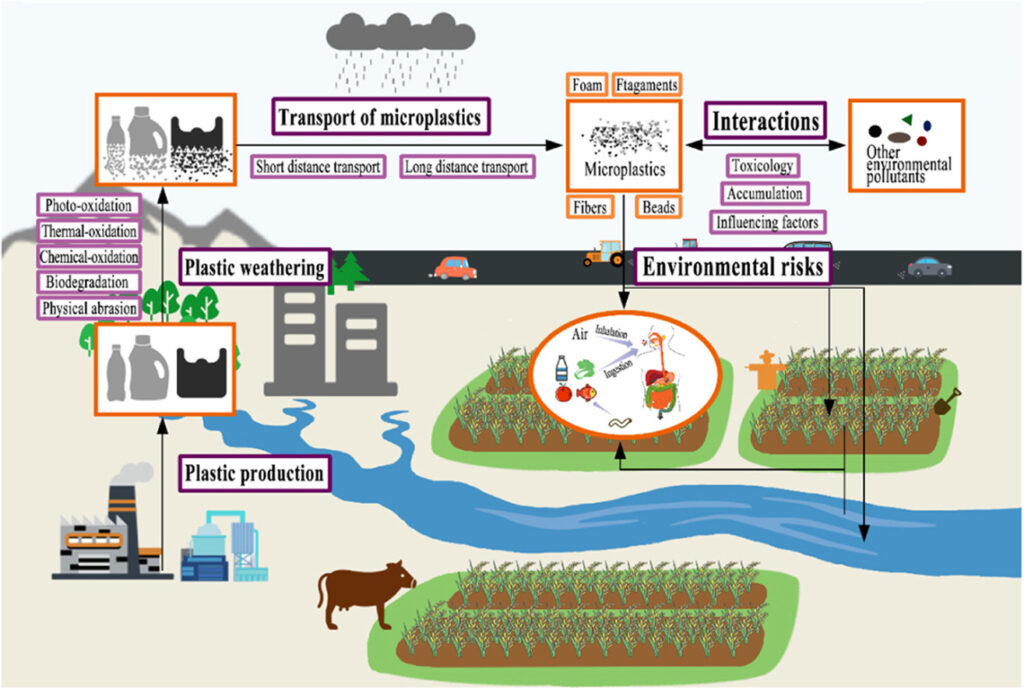
Impact of Microplastics on Living Organisms
The accumulation of microplastics results in an increase in microplastic exposure, thus resulting in a higher microplastic burden on the body. As microplastics accumulate in the body, typical excretion methods become overburdened and immune cells may become activated. These immune cells can help eliminate the microplastics but inflammation can arise as a result. It is also seen throughout the literature that microplastics can enter the cell and result in decreased cell viability via DNA damage when the concentration of microplastics reaches as little as 12 ug/ml.
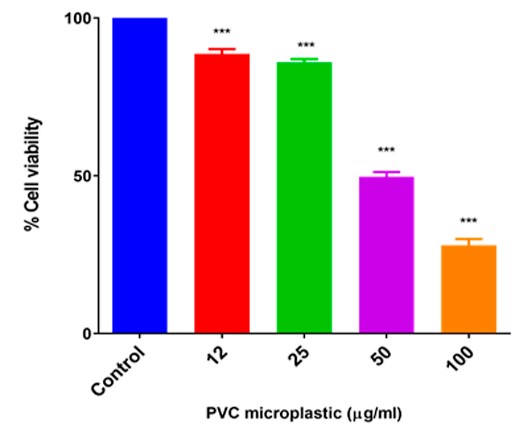
As seen in this figure, as the concentration of microplastics increases, the cell viability of human lymphocytes decreases. Cell viability refers to survival, and PVC is polyvinyl chloride, a type of microplastic. The significance of this work resides in the impact of microplastics on lymphocytes, which are immune cells.
Since an increase in microplastic concentration kills more lymphocytes, the resulting exposure of lymphocytes to microplastics creates a more susceptible immune system. More specifically, lymphocytes are a class of immune cells that houses B cells, T cells, and natural killer cells. These immune cells are crucial in protecting the body from bacteria, cancer, and viral infections.
Certain microplastics are directly harmful to specific regions in the body such as reproductive organs. A 2022 study found that polystyrene microplastics (PS-MPs) exposed to UV light resulted in reproductive toxicity in C. elegans.

The first experiment examined the number of cell corpses, or dead cells, per gonad after exposure to UV-exposed PS-MPs. The results indicate that UV-exposed PS-MPs induced cellular apoptosis at a higher rate than gonadal cells not exposed to PS-MPs, suggesting that these microplastics are indeed toxic to reproductive organs.
The results from this paper confirm that PS-MPs exposed to UV light result in DNA damage which leads to cell death in reproductive organs.
The last study of interest involved investigating the effect of chlorine on polystyrene microplastics. Since a good amount of PS-MPs can be removed from water through filtration, the impact of chlorine on PS-MPs remains unknown. However, it has been reported a significant portion of PS-MPs can pass through the filtration step of water treatment and onto a chlorine disinfection step, thus interacting with the PS-MPs. This study found that when PS-MPs was treated with chlorine, a significant increase in cell reactivity and toxicity was observed.
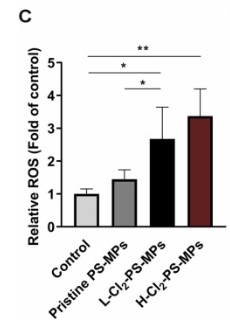
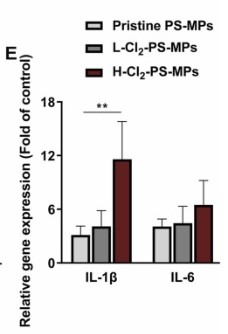
In the first figure (C), reactive oxygen species (ROS) is significantly increased in all chlorine-treated PS-MP groups compared to untreated (pristine) and control groups. In the second figure (E), PS-MPs treated with high amounts of chlorine (H-Cl2) resulted in significantly elevated IL-1beta, a gene that encodes the IL-1beta cytokine, suggesting that exposure to PS-MPs treated with H-Cl2 results in a change of in immune signaling.
- IL-1beta: Cytokines are messengers of the immune system, and IL-1beta is a proinflammatory cytokine. Proinflammatory cytokines promote the secretion of inflammatory molecules and help prepare the immune cell to fight off foreign invaders.
Another experiment involved looking at the percentage of apoptotic cells of different cell populations treated with the different PS-MPs or control. This figure portrays the results, and it was concluded that PS-MPs exposed to low or high chlorine levels significantly elevated the percentage of apoptotic cells suggesting that the exposure was cytotoxic. Future studies of this sort should be verified using pro-inflammatory markers like tumor necrosis factor-alpha (TNF-alpha).
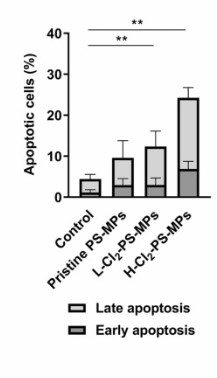
The increasing abundance of microplastics is of the utmost concern, and future studies evaluating more effective and efficient methods of clearing microplastics from water are needed. As microplastics accumulate in the soil, they can be taken up into the roots of plants, and eaten, thereby passing the microplastics into the body. Microplastics can also be ingested via drinking water, contact with plastics, and even inhaled from the air. When the concentration of these microplastics increases, they have a negative impact on cell viability, DNA integrity, and inflammatory processes.
Common Microplastic Sources
Exposure to microplastics can vary drastically depending on location and lifestyle. A quite common source of microplastics, quite recently discovered is through inhalation. This source of microplastics is strongly correlated with location, with industrial cities having more airborne microplastics. Since leaving a city is not practical, here are a few more common sources of microplastics.
Although certain seafood dishes are more documented than others, mollusks are among the most microplastic-rich sea creature. If 300 grams of mollusk were consumed each week, an annual 89200 microplastic items would have been ingested from mollusks alone. It seems as if fish contain much less, however, with a lack of data supporting this claim, it should be taken with caution.
Another source of microplastics is salt. Several studies have found that sea salt contains microplastics derived from plastic waste found in the ocean. Salt is a major nutrient in the body and its intake is critical for regulating blood pressure, pH balance, and membrane ionization. Since salt cannot be avoided consumption of microplastics is inevitable, however, most people in the United States consume double the amount of salt recommended (10g vs 5g), thus doubling their exposure to microplastics.
The last major contributor of MPs is water, a non-negotiable liquid. The average American consumes 1.4 liters of water each day, with 23 microplastic items per liter, the annual ingestion equates to 11,753 microplastic items. This is water from water treatment plants, with tap water containing up to 61 microplastic items per liter, and bottled water with up to 1000 microplastic items per liter. With these upper limit values and an intake of 1.4 liters per day, tap water consumption results in 31,000 microplastic items per year, and bottled water consumption equates to 511,000 microplastic items per year. These are the upper limit values with the mean being roughly half of the reported value: 5,876 items/year for treated water, 15,500 items/year for tap water, and 255,500 items/year for bottled water consumers drinking 1.4 liters a day.
It should be noted that food contained within plastic wrap or packaging also contains microplastic items at around 11,000 microplastic items/year, with this number drastically increasing depending on the frequency of eating take-out or heating up food in packaging. Another important note is that the current method for detecting the presence of microplastic items is not optimal and future values will have to be adjusted in tandem with advances in detection technology.
Limiting Exposure to Microplastic Items
Hopefully, this article has not been too negative, as there are plenty of ways to limit exposure to microplastic items. The first being limit bottled water consumption, water in cans or from the tap already cuts the exposure to microplastics by more than 90% compared to individuals consuming all bottled water. The next step is to limit take-out and plastic storage. Since take-out containers and pre-packaged foods are packaged in plastic and oftentimes require heating, limiting consumption of these foods can cut microplastic exposure by 5,000 items per year. The last major lifestyle change is to limit salt intake, especially sea salt, to the recommended daily intake (5g), and in doing so can cut exposure by nearly 2,000 items per year. Exposure by inhalation is arguably the largest contributor to microplastic exposure, however, without better detection and data a proper method of limiting airborne microplastics is not well-supported.
Conclusion
Plastic is one of the world’s most commonly used packaging material and makes up 593 billion dollars in the United States alone. With the continued use of plastic, the advancements of recycling technology have not caught up, therefore leading to massive landfills and stretches of ocean engulfed by this malleable material. As wind, water, UV light, and mechanical forces slowly degrade this plastic, microplastic particles are released into the soil and drinking water. As temperatures rise, more plastic will be degraded and deposited into the body, therefore practical tools to limit the toxic effects of microplastic accumulation are needed. Some of these practices include limiting bottled water consumption, pre-packaged/processed foods, and regulating sea salt intake, however, global efforts must be made to improve recycling technology and limit microplastic deposition into drinking water, air, and the soil.